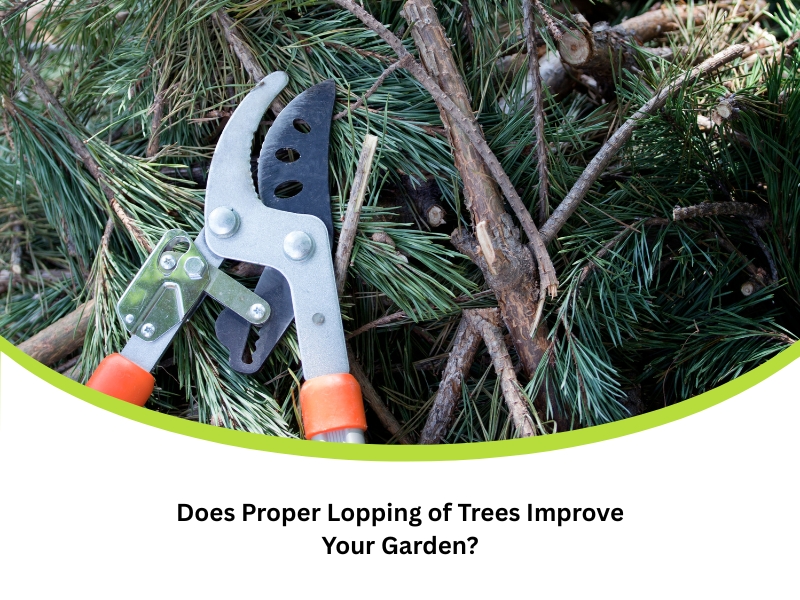Does Proper Lopping of Trees Improve Your Garden?
If your garden’s starting to look overgrown or patchy, your trees might be sending a quiet distress signal. Lopping of trees isn’t just about tidying up appearances — it’s a practical way to protect plant health, prevent damage, and keep your outdoor space functional and safe. While a few snips here and there might seem harmless, knowing when, why, and how to lop trees correctly can make a real difference. Tree lopping, done right, reshapes more than just the canopy — it sets the tone for your garden’s entire look and feel. But it’s easy to overdo or mistime it, and that can lead to stunted growth, disease, or worse. This article explains when and why to lop, the consequences of a botched job, and how you can approach the task with confidence.
What are the signs that indicate a tree needs lopping?
Here are common signs that a tree is due for a strategic lopping.
- Hazardous proximity: Branches are growing dangerously close to powerlines or rooftops.
- Shaded understory: The canopy has grown too dense, blocking sunlight from reaching the plants below.
- Deadwood presence: Dead, damaged, or diseased limbs are still attached, risking sudden limb fall.
- Structural imbalance: The tree’s shape is lopsided or top-heavy, affecting both appearance and balance.
- Uncontrolled growth: Saplings or water shoots are sprouting in awkward directions.
When these symptoms are visible, it’s smart to discover safe and effective tree lopping options for gardens before structural or safety issues escalate.
What role does tree lopping play in preventing disease and decay?
Lopping is a key part of proactive disease control and long-term tree care.
- Infection containment: Diseased branches can be cut off before pathogens spread through the trunk.
- Fungal prevention: Removing weak or shaded limbs reduces moisture build-up that fungi love.
- Airflow boost: Thinner canopies allow for more light and ventilation, helping to dry out damp areas.
- Pest deterrent: Healthier trees with open canopies are less likely to attract insects and termites.
- Healing support: Strategic cuts help redirect the tree’s energy toward recovery.
To reduce risks and ensure positive outcomes, it’s essential to follow proven methods for managing risks associated with tree trimming and removal, especially when dealing with complex growth structures.
What are the risks of DIY tree lopping without expert guidance?
Tree lopping isn’t a weekend DIY task — here’s what can go wrong without proper knowledge.
- Injury risk: Falls or equipment mishandling cause most tree-trimming injuries.
- Tree damage: Incorrect cuts lead to dieback, infections, and weakened structure.
- Regrowth problems: Poor technique causes excessive shoot growth that’s hard to manage later.
- Legal complications: Damaging protected trees or neighbouring property can result in penalties.
- Environmental harm: Over-trimming disrupts native wildlife habitat and tree ecosystems.
Mistakes often stem from not understanding species-specific needs, especially if you disregard the proper practices for pruning fruit trees, which can help achieve a balanced and sustainable lopping.
Which tree species benefits most from regular lopping?
Not all trees appreciate a heavy hand, but these species usually thrive with regular trimming.
- Eucalyptus management: Lopping reduces the risk of sudden limb drop in older gums.
- Jacaranda shaping: Regular trimming preserves structure and maximises flowering spread.
- Citrus pruning: Encourages air circulation and light for better fruit yields.
- Bottlebrush renewal: Blooms appear on new growth, so light lopping boosts flowering.
- Paperbark balance: Prevents top-heaviness that can lead to splitting.
Every species responds differently — the goal is to manage growth, encourage health, and avoid structural failure.
When is the optimal time of year for the lopping of trees in Sydney?
Timing your cuts improves healing and minimises stress on the tree. Here’s how seasons stack up:
| Season | Ideal For | Why It Works | Risk Factor |
| Late Winter | Reshaping and thinning | Trees are dormant, cuts heal before growth | Low |
| Early Spring | Light pruning | Supports blooming and fruiting | Moderate |
| Summer | Emergency cuts only | Prevents damage after storms | High |
| Autumn | Disease management | Clears rot before winter | Medium |
- Winter advantage: Structural pruning is easiest when leaves are sparse,
- Spring balance: Light work supports regrowth without stunting blooms,
- Summer risk: Avoid harsh trimming during extreme heat.
- Autumn caution: Check the forecast for rain before trimming to avoid moisture lock-in.
To avoid hazards and improve outcomes, it is essential to understand safety measures in tree lopping procedures, especially when working near property lines or structures.
How does the lopping of trees enhance safety around your property?
A trimmed tree is a safer tree for homes, fences, and people nearby.
- Overhang control: Removes limbs above walkways, roofs, and carports to avoid impact damage.
- Fire risk reduction: Lopped trees create space between foliage and structures in bushfire zones.
- Gutter protection: Cuts stop branches from clogging or damaging roof systems.
- Sightline clearing improves visibility near driveways and roads, thereby lowering accident risk.
- Storm resilience: Reduces weight on limbs, lowering the chance of breakage during high winds.
Beyond aesthetics, strategic lopping actively prevents damage and improves site access and visibility.
Are there legal considerations to be aware of before the lopping of trees?
Before reaching for the saw, check if your tree is protected under local regulations.
- Council approval: Most Sydney councils require permits for trees over a certain height or girth.
- Protected species: Some native and heritage trees can’t be trimmed without approval.
- Boundary trees: Trimming shared trees may require neighbour consent under NSW laws.
- Arborist reports: Councils may need formal assessments for risk or health before approving.
- Costly mistakes: Fines for unauthorised lopping exceed $10,000 in many local government areas.
Where rules are unclear, speaking with a certified arborist or local council helps you stay compliant and informed.
Final thoughts
The lopping of trees, when done thoughtfully, can improve your garden’s structure, health, and safety. But poor technique or bad timing can undo all your hard work. Knowing your tree species, watching for the right seasonal window, and keeping a light but strategic hand is the way to go. Suppose you’re unsure about where to begin exploring how All Green Gardening & Landscaping can assist your garden with practical solutions that can help match your landscape’s unique needs.


